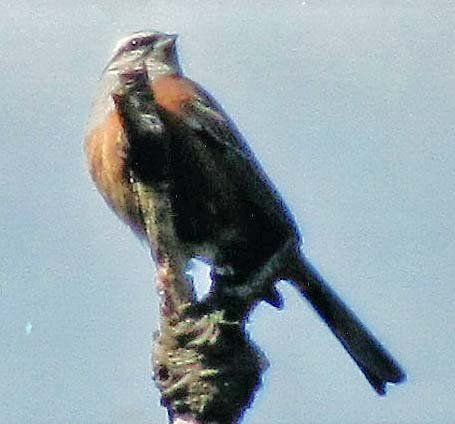- Home
- General Information
- Sightings
- Birding Locations
- Publications
-
Archive 1987 - 2018
- A Checklist of Bradford's Birds
- Swans & Geese
- Ducks & Sawbills
- Divers, Grebes, Herons
- Eagles, Kites & Harriers
- Buzzards & Hawks
- Falcons
- Grouse, Quail, Crakes
- Waders - Part1
- Waders - Part 2
- Skuas and Gulls
- Terns & Auks
- Doves, Nightjar & Alpine Swift
- Hoopoe, Wryneck, Larks, Pipits
- Owls, Woodpeckers
- Thrushes
- Warblers and Tits
- Shrikes and Crows
- Sparrows, Buntings and Finches
- Gallery
Sparrows, Buntings and Finches
TREE SPARROW
Passer montanus
Increasingly common, resident breeder.
Sightings since 2014:
2014
- The remarkable progress referred to in recent Reports has been maintained for this species. This is almost certainly due to the tireless work of one individual who has continued the monitoring of nest-boxes in Wharfedale. Once more over 200 nestlings were accounted for and most were ringed at the main sites at Timble (44), Sun Lane (58) and Clifton (93). At Farnley School, there were four nests all in House Martin boxes and there was a similar situation at Timble village, where it was thought there may have been broods totalling 20 birds. In the Washburn, four broods raised 18 young and there was probable breeding at Beaverdyke, Addingham, and Embsay.
2015
- The resurgence of this species continues in the north of the area, where the hot spots are in habitats close to villages in Wharfedale and the Washburn. In particular Clifton, Timble, Farnley and Sun Hill Nature Reserve all featured, with 52 nest boxes producing 162 young, all of which were ringed. At Timble (28), Sun Lane (50) and Clifton (68) numbers were down on last year and this pattern was confirmed from the Washburn, where brood sizes of two or three were common, compared with the usual four or five. In winter, up to 12 birds regularly visited a garden in Addingham, where a pair successfully used a nest box in June.
2016
- Breeding took place at seven locations in the north of the area where boxes had been erected. At Sun Lane NR, from 13 nests, 37 young were successfully raised. At Clifton and Timble village, nine boxes produced 34 young and at the four other locations where single boxes were situated, adults successfully raised broods. Breeding also took place at a regular site at Beaverdyke, where adults were seen in March. There was also a report of at least four birds near Shelf in February and a post-breeding flock of ten was seen feeding on sorrel at Glovershaw in July. Small flocks were reported close by at Sconce and also at Dobrudden Farm on Baildon Moor, both in December.
2017
- There is evidence birds are spreading out from the areas where they have been found in recent years, and Addingham, Ben Rhydding, Bland Hill, Menston and Otley were specifically mentioned. The species was also present around Baildon Moor with feeders attracting up to seven birds at Dobrudden Farm. Breeding again evidently took place in Burley, Clifton, Menston and Timble, and a minimum of 54 juveniles were seen.
2018
- There were more reports this year from Airedale, and birds were seen at places previously unrecorded: Haverah Park, Judy Woods, Silsden and Thornthwaite. The best count was 20 birds at Addingham in July, though it was suggested up to 50 might have been in the area. As last year, there was successful breeding at Burley, Menston and Clifton, and the minimum of 61 young was also in line.
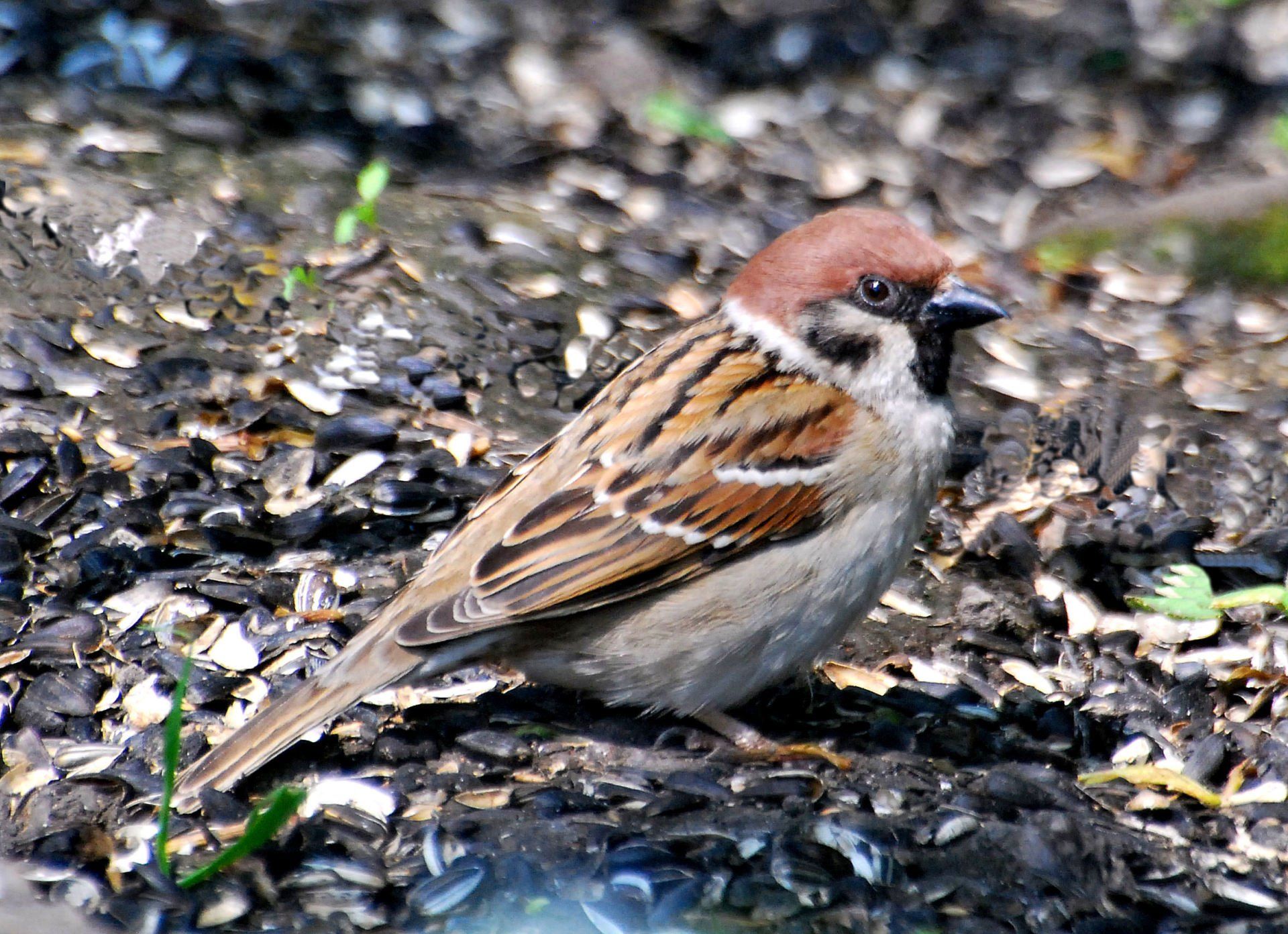
Tree Sparrow
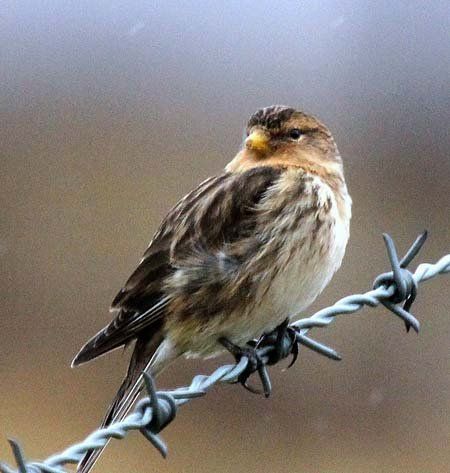
Twite at Fly Flatts photo: Brian Sumner
TWITE
Carduelis flavirostris
Very uncommon and local; mainly on migration.
2012
- Records and numbers continue to reduce. The previously reliable Warley Moor feeding station was reduced to no more than four birds in March, but three birds were at Leeshaw (another past stronghold) on 26th June, and Soil Hill provided some respectability, with up to 11 between 30th October and 1st November. A total of eight passed Oxenhope watchpoint on October movement.
2013
- Just two records, both from the previously reliable Warley Moor feeding station, represents the nadir for this moorland species. Two birds were feeding on niger seeds on 21st April and 6th May.
2014
- This was the worst-ever year with just two records, both from the south of the area. A single bird was seen by the roadside at Warley Moor Reservoir on 11th June and the other was seen flying over Oxenhope watchpoint on 4th November.
2015
- Relatively speaking, it was a much better year after recent disasters. The seven records referred to 20 birds all seen between 1st July, when three were feeding on Soil Hill and 20th December, when eight appeared at Redcar Tarn. On two occasions in August, Soil Hill had two others and at Kex Gill on 13th November, a single was watched. The other four birds passed observers at Oxenhope; a single on 23rd September and a trio on 12th October. Birders have been encouraged to spread nyjer seeds at Leeshaw Reservoir, Soil Hill and at Warley Moor Reservoir, where the species is most likely to feed.
2016
- A very sad story for our local Twite population with numbers depreciating yearly despite an extensive Nyjer seed feeding programme at known popular sites, mainly Warley Moor Reservoir, once a hotspot for this species where flocks of up to 30 Twite could be seen on a regular basis. Reports this year were down to a mere four sightings, three of these being single birds. The first record was of 12 birds at Warley Moor Reservoir on 14th April near the feeding station. A single was at Denholme Edge amongst a flock of Linnets on 23rd May (JB), whilst the last two sightings were during the autumn migration period with one at the Oxenhope Watchpoint on 21st October and another on the track to Keighley Moor Reservoir on 2nd November.
2017
- Though rescued by a total of 21 birds seen on migration at Oxenhope Watchpoint, the general decline cannot be hidden, and two birds at Warley Moor Reservoir on 29th October was the only other contribution.
2018 - Twite is just clinging on in the Warley Moor area, and five were found on 11th September, and one on 19th October. On the same date, an apparent migrant was seen near Scargill Reservoir.
COMMON (MEALY) REDPOLL
Carduelis flammea
Passage and winter visitor, occasional breeder.
Reported occasionally 1987 - 2005. Most recent sightings:
2007
- A large redpoll flock of around 100 at Lindley Wood Reservoir on 2nd and 5th April included at least 20 birds which showed themselves well enough to be identified as this species, and the possibility is that they all were. At the other end of the year, there were three at Denholme Clough on 9th October, and two with Lesser Redpolls at Snaygill on 8th December. All the birds were attributable to the nominate species, C.f.flammea, Mealy Redpoll.
2008
- Four birds were at Otley Wetland on 4th February.
2011
- Birds using garden feeders produced the first records since 2008. One was in Riddlesden on 2nd and 25th February, and another in Ilkley on 15th March.
2013
- Five birds were ringed at Timble Ings on 30th October (AJ).
2016
- One was seen amongst a large flock of 100 Lesser Redpoll at Swinsty Reservoir on 29th December. This was the first record since 2013, when five birds were ringed at Timble Ings.
2018
- A welcome bonus to the redpoll ringing activity at Timble Ings on 27th November was one of this species, not seen since 2016.
ARCTIC REDPOLL
Carduelis hornemanni
Vagrant
1996
- Whilst several examples of this species were suspected amongst the flocks of Redpolls, reports with descriptions were received for only one bird: a bird found at Fewston Reservoir on 31st March. A further bird observed with a small flock of Common Redpoll at Timble Ings on 19th April was believed to be of this species, but unfortunately views were too brief to permit the required detailed description to be submitted.
HAWFINCH
Coccothraustes coccothraustes
Infrequent visitor
1987
- All records of this local rarity came from Meagill Rise, Otley, with six on 25th, one on 26th, two on 29th and one on 31st January. In February, one was present on 5th and two on 7th.
1988
- A secretive and very scarce local species. There was a single seen and heard at Esholt Hall on 30th October.
1990
- A pair was suspected of breeding at Bolton Abbey with birds being reported during both May and June; one was observed feeding at very close range on 8th June was seen carrying food several times. The only other report concerned a pair at the disused children’s home at Menston on 17th April.
1992
- A single bird flying over Red Beck Allotments at Shipley on 30th November.
1994
- One visted a garden in Copley on several dates in early for June and the second was seen at Timble by several observers in the same tree (and same telescope view) as a Rough Legged Buzzard on 29th October.
2001
- A bird seen on 25th January with other finches near the Cavendish Pavilion, Bolton Abbey, was the first Group record for over six year.
2005
- A bird seen at the edge of Timble Ings on 1st, 5th and 21st January was clearly one of the two that had been present there at the end of December, 2004.
2011
- Not recorded since 2005, so one at St. Ives was an excellent find on 30th January (MD). It was much appreciated by many onlookers until last seen on 9th March
2012
- A bird well seen as it flew past Caldene Fields on 5th November provided a record for the second successive year.
2016
- Two birds were seen feeding on the ground in a Baildon garden on 6th February. This was the first record since 2012 and only the 10th year in the last 30 that these scarce birds have been reported.
2017
- It might have been expected that a bird in the lower Washburn Valley on 12th March would have been the year’s only record, but this was changed by a big national influx of the species in autumn. This resulted in an unprecedented number of Group records, which came from seven sites. A bird passing Caldene Fields on 26th October got things going, with another on 1st November, and two on 30th October. Another passage bird was seen at Denholme Clough on the 29th, and three local cemeteries then produced birds. At Ilkley up to four birds were present between 30th October and the year-end, two were at Otley the day after, and a single at Bingley on 13th November. Additional Wharfedale reports came from Strid Wood, where four were seen on 1st November, and two were in Middleton Woods on 28th December.
2018
- Birds were seen in the early months, and comprised those remaining, following the major influx at the end of 2017. At Ilkley Cemetery, up to four birds remained until 3rd March, and Otley Cemetery still had a bird to 5th February, and five were reported from there on 26th January. Away from here, one passed Caldene Fields on 14th November.
TWO-BARRED CROSSBILL
Loxia leucoptera
Rare vagrant nationally
2008
- A first for the Group and for West Yorkshire, this record is all the more remarkable for the bird having been discovered at a garden feeder in Oakworth on 29th October. The bird, a male, was photographed during its stay, which, unfortunately, was all too brief, as it was taken by a Sparrowhawk.
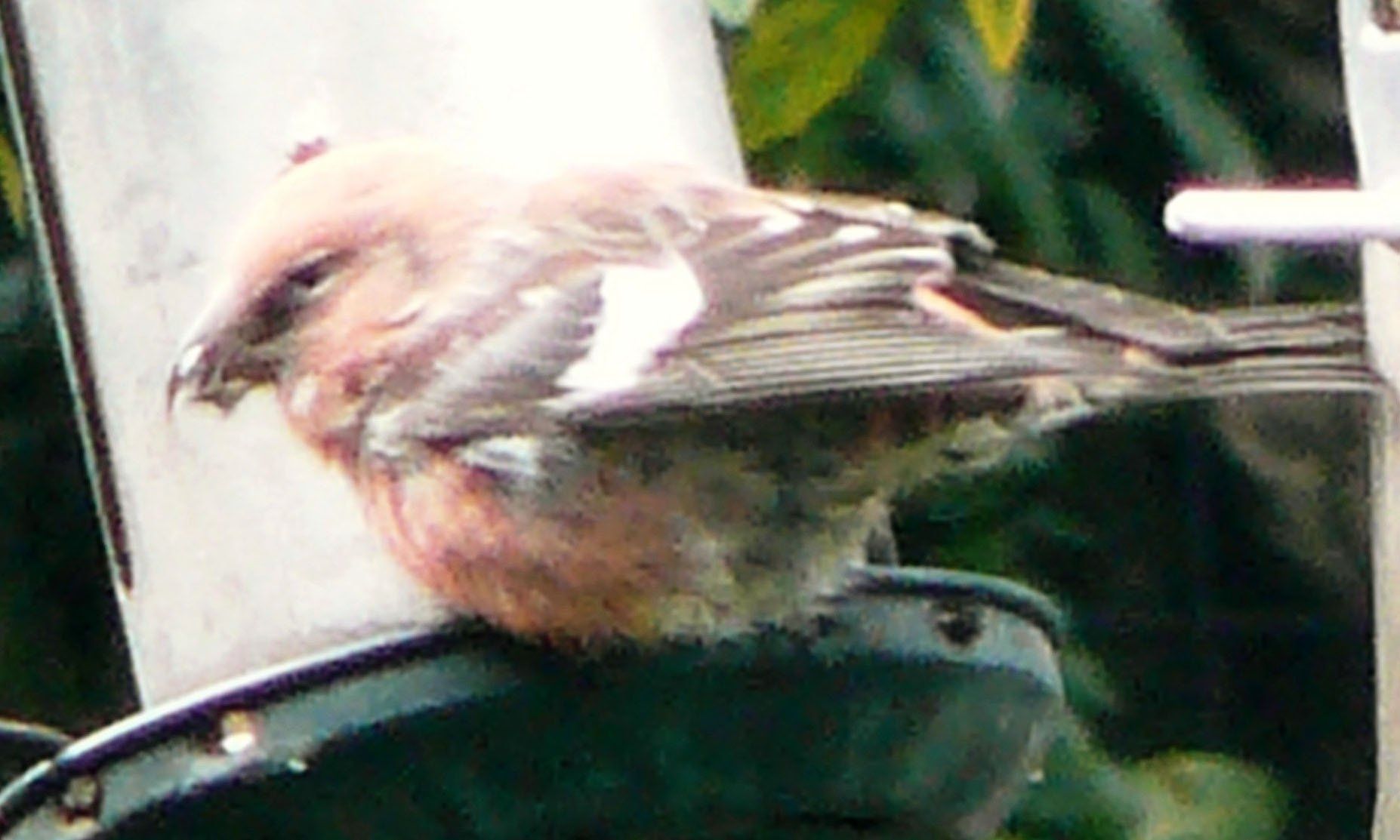
LAPLAND BUNTING
Calcarius lapponicus
Scarce visitor
recorded: 1989, 1991, 1993, 1994 and 1999. Records since 1999:
2000
- The first record was of a bird flushed, and watched at close range at Buck Stones on 29th September, followed by two records from Kex Gill Quarry on 17th and 22nd October.
2009
- There were two records of a species not reported in the area for nine years, and concerned individuals which passed Thornton Moor on 23rd September, and Timble Ings on 13th October.
2010
- A good year at Thornton Moor turned up a total of at least 11 birds on 12th, 23rd, 25th, and 26th September, and 11th, 17th, and 23rd October. Others flying over on a further eight dates around this time (when there was a considerable national influx) could have been this species.
2011
- A bird was seen twice briefly on Soil Hill on 12th December, but couldn’t be relocated.
2015
- A bird was seen on Keighley Moor on 20th November, the first recorded since 2011.
2016
- Two birds were picked up as they flew, whilst calling, over the heads of observers at Oxenhope Watchpoint. Both were in October, on the 1st and the 29th. This was the second consecutive year that this species has been reported.
SNOW BUNTING
Plectrophenax nivalis
Infrequent passage/winter visitor.
Seen as singles or in very small numbers 1987 to 2012. Recent sightings:
2012
- Many of the records were dependent on the birds on Soil Hill overwintering from the end of 2011, and between 5th and 13th January up to nine birds were seen, with a maximum of four there in February. This fairly reliable location had all but one of the remaining records, comprising singles on 18th March, 19th October, and 3rd and 26th November, two on the following day, and four on 8th December. The remaining bird was one past Oxenhope on 18th September.
2013
- There were four records, all in the latter part of the year and concerned a total of five birds. The first was a bird at Timble Ings on 30th October, and another was feeding at the roadside at Whetstone Gate on 18th November. A week later, two birds were seen on Burley Moor and the final report, a single on the normally reliable location of Soil Hill on 21st December.
2014
- There were nine records, all single birds, two in the first winter period and the others between October and December. In February, a bird was seen at Slippery Ford and on 12th March another was taking advantage of the seed beneath the masts at Whetstone Gate. On three dates between 10th October and 5th November, single birds flew over Oxenhope watchpoint. A bird was seen at Kex Gill on 5th November and four days later one was located on Soil Hill. The final two birds were seen in December, a single at Keighley Moor Reservoir (IH) and the other at Addingham Moorside.
2015
- The first two records were of females, one of which was at Warley Moor Reservoir on 1st January and the other on Soil Hill from 7th to 16th March. On 19th November, a male spent two days on Soil Hill and another was seen for two consecutive days on Keighley Moor from 20th November.
2016
- A bird seen feeding near Slade, on Warley Moor, on 17th October, was the only record.
2017
- A winter record of two birds briefly on Soil Hill on 8th January, was followed by one of a passage bird over Oxenhope Watchpoint on 16th October.
2018
- In October, one was seen on the 29th during a migration watch at Oxenhope, and the following day another photographed at the less likely Fewston Reservoir. Warley Moor Reservoir then had singles on 2nd and 28th December.
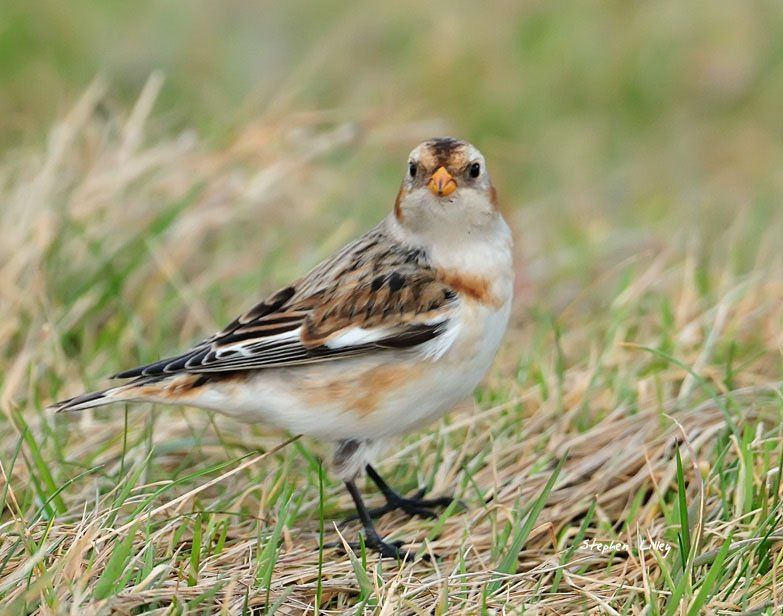
Snow Bunting photo: Stephen Lilley
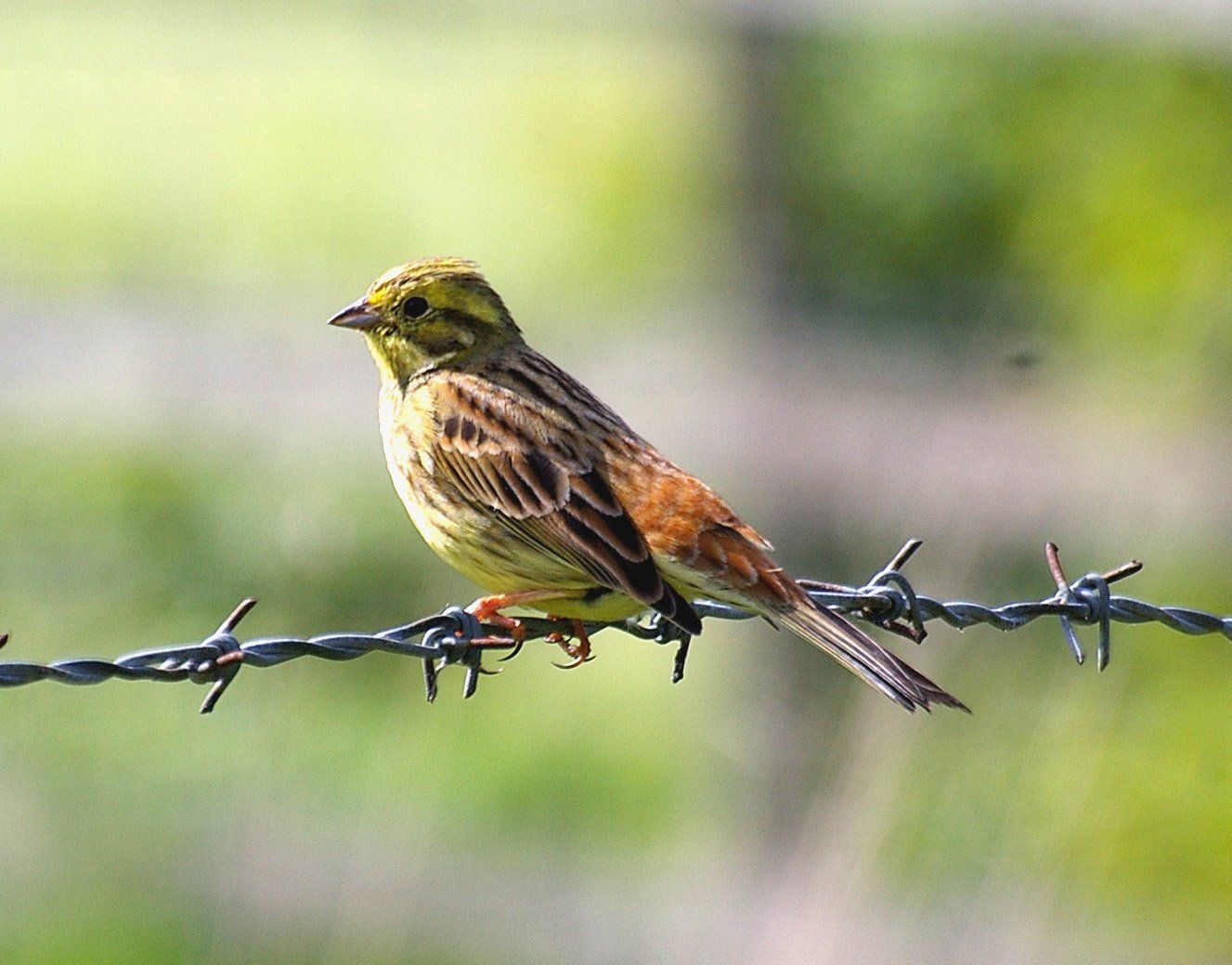
A Yellowhammer at Glovershaw in 2007 photo: Paul King
CORN BUNTING
Milaria calandra
Scarce visitor
1987
- A rare bird in the Bradford area, a single at Apperley Bridge on 11th January being the only record.
1988
- There was one in the Tong-Cockersdale Valley on 20th October.
1996
- An unexpected find was a (well described) bird feeding on animal fodder in a field off Gas Works Lane, Silsden on 26th March.
YELLOWHAMMER
Emberiza citrinella
Scarce and local resident/possible breeder.
A once common species is now in serious decline. Records only from the eastern fringes of the recording area.
2013
- Although there was a welcome return to reports featuring this once-thriving species, none of them point with any certainty to better times ahead. A bird in a mixed flock of finches was seen on Askwith Moor on the 21st August and three birds flew across Baildon Moor and another was noted at the Oxenhope Watchpoint in October. In February a bird was seen on Harden Moor, but there were no further reports from here.
2015
- After the first-ever blank year in 2014, a singing male was seen at Lindley Green above Lindley Wood Reservoir on 24th June.
2017
- A welcome return, after two recent blank years, concerned singles in March at Bradup on the 12th, and Knotford Nook on the 25th, one past Oxenhope on 22nd September, and another on Burley Moor on 6th October.
2018
- Not since 2011 have birds been seen at the former stronghold of Baildon Moor, and the bird’s continuing tenuous presence is now down to isolated records elsewhere. This year’s singles were seen at Queensbury on 5th April, at Otley Wetland on the 27th, and migrating past Caldene Fields on 11th November.
ROCK BUNTING
Emberiza cia
Exceptionally rare vagrant
2011
- A male bird, seen and photographed by a single observer close to Bolton Abbey on 8th May 2011, has now been accepted by the British Birds Rarities Committee. This is the sixth British record, only the third within the last 60 years. The last was in 1967. The observer’s name has been withheld as he wished to shun fame and fortune.
